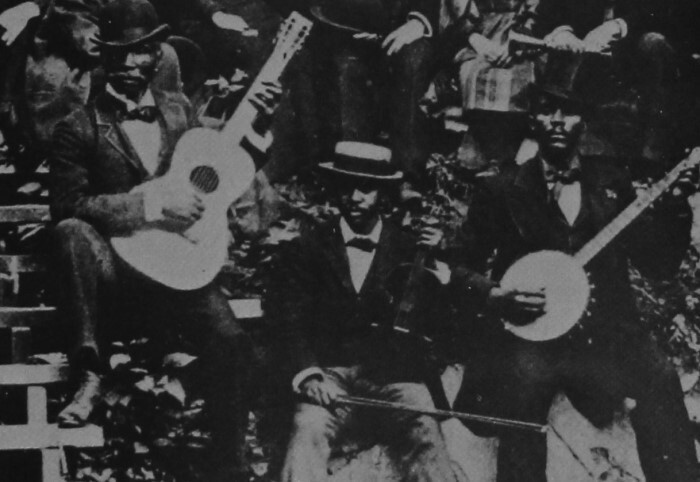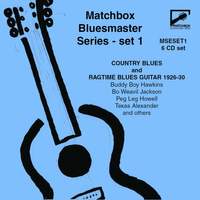Recording of the Week,
Matchbox Bluesmaster Series - Volumes 1 & 2
 This week I have been immersing myself in the root of all jazz, the blues, and the first two volumes in the Matchbox Bluesmaster series, which documents some of the earliest recordings of blues, ragtime, hokum and gospel music. Drawing on the legendary forty-two LP set released by the UK’s Saydisc Records in the eighties, Bluesmaster focuses on extremely rare 78s recorded between 1926 and 1934, with the overarching concept of the series being to provide insight into how Black music was first released on record. Looking back nearly a hundred years since they were first cut, when the various musical genres have become so codified and commercialised now, it’s interesting to note that blues and country were both essentially folk music, written and performed by both Black and white musicians, nearly all living in unimaginable poverty. The genre definitions were largely applied by white-owned record labels in the twenties who cooked up the marketing categories ‘race music’ and ‘hillbilly music’ to sell ‘music by blacks for blacks and by whites for whites’, respectively. At the time there was often no clear musical division between ‘blues’ and ‘country’ except for the colour of the performer’s skin, and in the days when Instagram was the stuff of a mad man’s dreams, the labels sometimes even got that bit wrong.
This week I have been immersing myself in the root of all jazz, the blues, and the first two volumes in the Matchbox Bluesmaster series, which documents some of the earliest recordings of blues, ragtime, hokum and gospel music. Drawing on the legendary forty-two LP set released by the UK’s Saydisc Records in the eighties, Bluesmaster focuses on extremely rare 78s recorded between 1926 and 1934, with the overarching concept of the series being to provide insight into how Black music was first released on record. Looking back nearly a hundred years since they were first cut, when the various musical genres have become so codified and commercialised now, it’s interesting to note that blues and country were both essentially folk music, written and performed by both Black and white musicians, nearly all living in unimaginable poverty. The genre definitions were largely applied by white-owned record labels in the twenties who cooked up the marketing categories ‘race music’ and ‘hillbilly music’ to sell ‘music by blacks for blacks and by whites for whites’, respectively. At the time there was often no clear musical division between ‘blues’ and ‘country’ except for the colour of the performer’s skin, and in the days when Instagram was the stuff of a mad man’s dreams, the labels sometimes even got that bit wrong.
Both of the present volumes focus on the country blues of the deeply segregated South, with Vol. 1 extending into ragtime blues, and Vol. 2 shining a spotlight on harp players. I appreciated that they have grouped together songs by each artist, affording us the opportunity to get to differentiate the styles between individual artists like Richard “Rabbit” Brown and William Moore, and several artists, such as Buddy Boy Hawkins, take up whole discs. With over 80 tracks in each volume I did initially wonder if they would hold my attention, but instead, I found incredible diversity and richness, especially in the unique approach each artist had to playing the guitar or wailing on a harmonica, and the sheer rawness of the emotion in each voice.
 Considering that these recordings were captured using the most basic equipment, the sound quality is largely surprisingly decent, the restoration job stripping away much of the crackle and hiss to reveal plenty of detail in the voices and instruments. Only in a few instances does the surface noise threaten to overpower the music (Skip James’s ‘4 O’Clock Blues’ being a particularly challenging example), but I actually found something rather haunting about these artefacts, hearing an echo from the past refusing to be buried in static. On the subject of Skip James, the disc devoted to him is one of the highlights of Volume 2. An artist who was rediscovered during (and still alive for) the blues revival of the sixties, anyone familiar with the music of the guitarist John Fahey will immediately hear the influence that James’s stark, open-tuned minor mode fingerpicking clearly had on that maverick’s playing.
Considering that these recordings were captured using the most basic equipment, the sound quality is largely surprisingly decent, the restoration job stripping away much of the crackle and hiss to reveal plenty of detail in the voices and instruments. Only in a few instances does the surface noise threaten to overpower the music (Skip James’s ‘4 O’Clock Blues’ being a particularly challenging example), but I actually found something rather haunting about these artefacts, hearing an echo from the past refusing to be buried in static. On the subject of Skip James, the disc devoted to him is one of the highlights of Volume 2. An artist who was rediscovered during (and still alive for) the blues revival of the sixties, anyone familiar with the music of the guitarist John Fahey will immediately hear the influence that James’s stark, open-tuned minor mode fingerpicking clearly had on that maverick’s playing.
It has been argued that the iconic image of the lone bluesman was partly a construct by the record labels, who preferred to record solo artists not only because the primitive recording technology was better at capturing solo voice and guitar rather than the complexity a full band, but also because they found group sessions often became boisterous affairs that were hard to control. So it’s a treat to hear music by a larger ensemble like the Dallas String Band, a family group led by Coley Jones, whose ‘Hokum Blues’ demonstrates that even as late as 1928 notions of what separated blues from jazz were not yet fixed. The subject matter of these songs belie the usual “woke up this mornin’” blues stereotypes as well, and so alongside songs about the woes of relationships and the hardships of working on the railroads, we find ballads about outlaws from society, and commentary on recent historical events, as in ‘Sinking of the Titanic’. Peg Leg Howell and Eddie Anthony’s ‘Turkey Buzzard Blues’ is a fine example of a blues violin hoedown, and I especially enjoyed the novelty skits of Freeman Stowers, which feature imitations of farmyard animal and train sounds on his harp. Many of the innovations made by these artists would ultimately feed directly into rhythm and blues, and then rock and roll, and you can already hear intimations of Chuck Berry’s chug in Stephen Tarter and Harry Gay’s ‘Brownie Blues”. I eagerly look forward to future volumes in the Bluesmaster series.
Buddy Boy Hawkins, Bo Weavil Jackson, Peg Leg Howell, Texas Alexander…
Available Formats: 6 CDs, MP3, FLAC
Skip James, Coley Jones, Leroy Carr…
Available Formats: 6 CDs, MP3, FLAC




